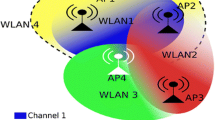Abstract
We consider a slotted ALOHA setting where backlogged, energy-constrained users selfishly select the probability with which they transmit packets. Packets are successfully received, even in case of collision, if the signal to interference plus noise ratio at the access point exceeds some threshold (power capture). The user problem of finding appropriate transmission probabilities is formulated as a static non-cooperative game and the performance limits for stationary and mobile scenarios are determined. The equilibrium analyses show that for stationary scenarios, users with high pathgains share the channel fairly while others never transmit. In the mobile case users utilize a binary strategy where they try to monopolize the channel when their pathgain exceeds some threshold that depends on system parameters (number of users, transmission costs, etc.). Otherwise they shut their transmitters off. Compared to traditional nondiscriminatory distributed multiaccess protocols the operating points achieved by selfish users generally increase sum-utility although this comes at the expense of larger user performance variations.








Similar content being viewed by others
Notes
This means that users would need to meet before the game is played so as to coordinate their actions in order to successfully reach this class of Nash equilibria.
From Fig. 2 it is evident that this situation is likely to occur when the propagation exponent α is low (and the received signal strength from different nodes do not differ by much at the access point) and/or when the signal to interference requirement is high.
For example consider the Nash equilibrium where one of the users monopolizes the channel. This equilibrium would only be achieved if one user attempts to monopolize the channel while all others select not to transmit. Reaching such an equilibrium in a single-shot game would require that users have a “signalling device” that allows them to “coordinate” their actions (cf. correlated equilibria).
Notice that the probability with which a randomly chosen user transmits a packet in PTG-I is \(\hbox{Pr}\left(g\geq F_g^{-1}\left(E^{1/N-1)}\right)\right)=1-\hbox{Pr}\left(g\leq F_g^{-1}\left(E^{1/N-1)}\right)\right)=1-F_g\left(F_g^{-1}\left(E^{1/(N-1)}\right)\right)=1-E^{1/(N-1)}\). This is the same probability with which a user transmits when capture prospects are not taken into consideration.
References
Mitola, J., & Maguire, G. Q. Jr. (1999). Cognitive radio: Making software radios more personal. IEEE Personal Communications, 6(4), 13–18.
Saraydar, C. U., Mandayam, N. B., & Goodman, D. J. (2001). Pricing and power control in multi-cell wireless data networks. IEEE Journal on Selected Areas in Communications, 19(10), 1883–1892.
Felegyhazi, M., Buttyn, L., & Hubaux J.-P. (2003). Equilibrium analysis of packet forwarding strategies in wireless ad hoc networks—the static case. Technical Report IC/2003/03, Laboratory of Computer Communications and Applications, Swiss Federal Institute of Technology, Lausanne.
Nie, N., & Comaniciu, C. (2006). Adaptive channel allocation spectrum etiquette for cognitive radio networks. Mobile networks and applications, 100, 779–797.
Levorato, M., Casari, P., & Zorzi, M. (2006). On the performance of access strategies for MIMO ad hoc networks. In Proceedings of IEEE globecom.
Mathur, S., Sankar, L., & Mandayam, N. B. (2008). Coalitions in cooperative wireless networks. IEEE Journal on Selected Areas in Communications, 26(7), 1104–1115.
MacKenzie, A. B., & Wicker, S. B. (2001). Selfish users in ALOHA: A game-theoretic approach. In Proceedings of the 54th vehicular technology conference (Vol. 3, pp. 1354–1357). Atlantic City, USA, October 2001.
Inaltekin, H., & Wicker, S. (2005). A one-shot random access game for wireless networks. In Proceedings of the international conference on wireless networks, communication and mobile computing (Vol. 2, pp. 940–945).
Inaltekin, H., & Wicker, S. (2006). The analysis of game theoretic MAC protocol for wireless networks. In Proceedings of the annual IEEE communication society on sensor and ad hoc communications and networks (Vol. 1, pp. 296–305).
Cagalj, M., Ganeriwal, S., Aad, I., & Hubaux, J.-P. (2005). On selfish behavior in CSMA/CA networks. In Proceedings of the 24th annual joint conference of the IEEE computer and communication societies (INFOCOM) (Vol. 4, pp. 2513–2524). Miami, USA, March 2005.
Cho, Y., Hwang, C. S., & Tobagi, F. A. (2008) Design of robust random access protocols for wireless networks using game theoretic models. IEEE INFOCOM. Phoenix, April 2008.
Sagaduyu, Y. E., & Ephremides, A. (2006). A game-theoretic look at throughput and stability in random access. In Proceedings of the military communications conference (MILCOM) (pp. 1–7).
MacKenzie, A. B., & Wicker, S. B. (2003). Stability of multipacket slotted ALOHA with selfish users and perfect information. In Proceedings of twenty-second annual joint conference of the IEEE computer and communication societies (INFOCOM) (Vol. 3, pp. 1580–1590).
Cho, Y., & Tobagi, F. A. (2008). Cooperative and non-cooperative aloha games with channel capture. In Proceedings of IEEE Globecom. December.
Krishnamurthy, V., & Ngo, M. H. (2005). A game theoratical approach for transmission strategies in slotted aloha networks with multi-packet reception. In IEEE international conference on acoustics, speech, and signal processing (ICASSP). Philadelphia, March 2005.
Ngo, M. H., & Krishnamurthy, V. (2007). Game theoretic cross-layer transmission policies in multipacket reception wireless networks. IEEE Transactions on Signal Processing, 55(5), 1911–1926 May 2007.
Lee, H., Kwon, H., Motskin, A., & Guibas, L. (2009). Interference-aware MAC protocols for wireless networks by a game-theoretic approach. In Proceedings of the IEEE infocom. April 2009.
Fudenberg, D., & Tirole, J. (1991). Game theory. Cambridge: MIT Press.
Author information
Authors and Affiliations
Corresponding author
Rights and permissions
About this article
Cite this article
Hultell, J., Ileri, Ö. & Zander, J. Selfish users in energy constrained ALOHA systems with power capture. Wireless Netw 17, 199–212 (2011). https://doi.org/10.1007/s11276-010-0273-z
Published:
Issue Date:
DOI: https://doi.org/10.1007/s11276-010-0273-z




